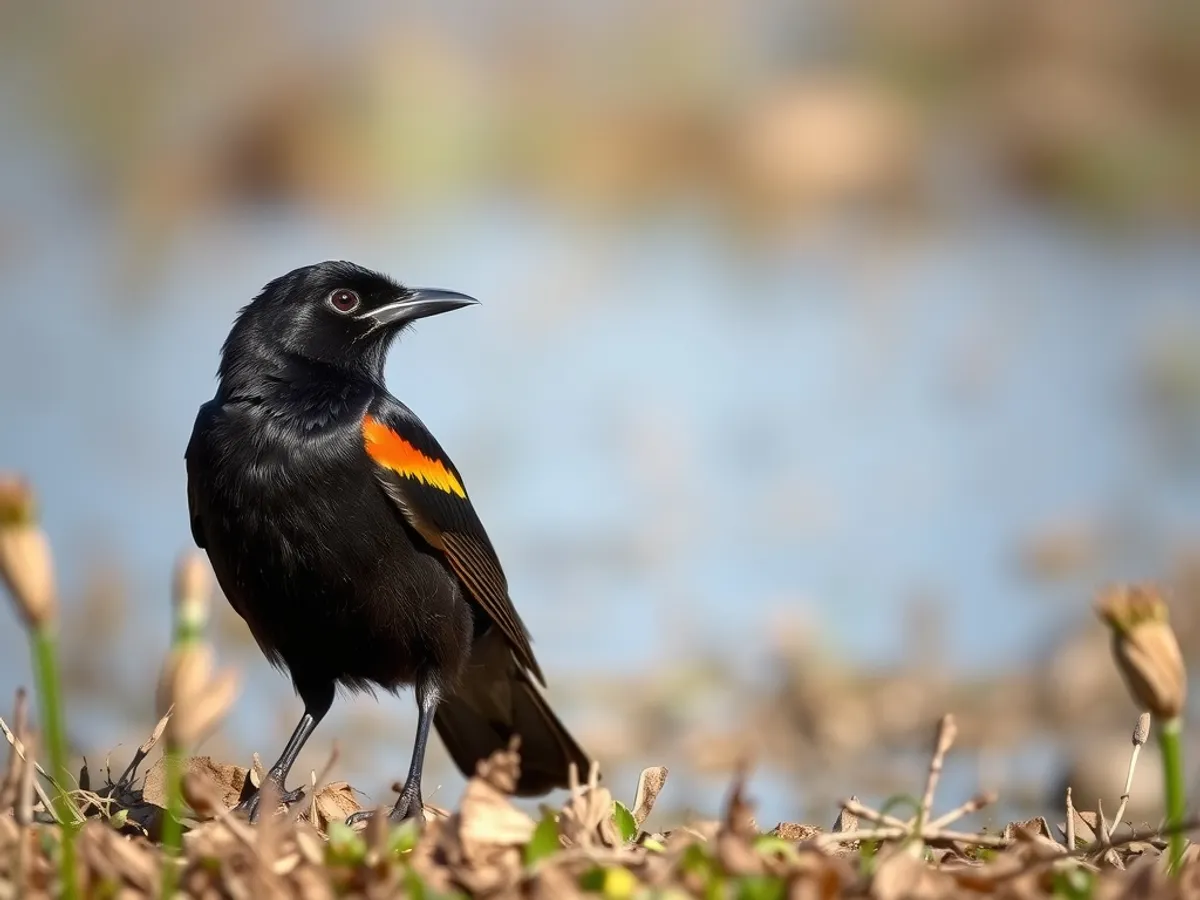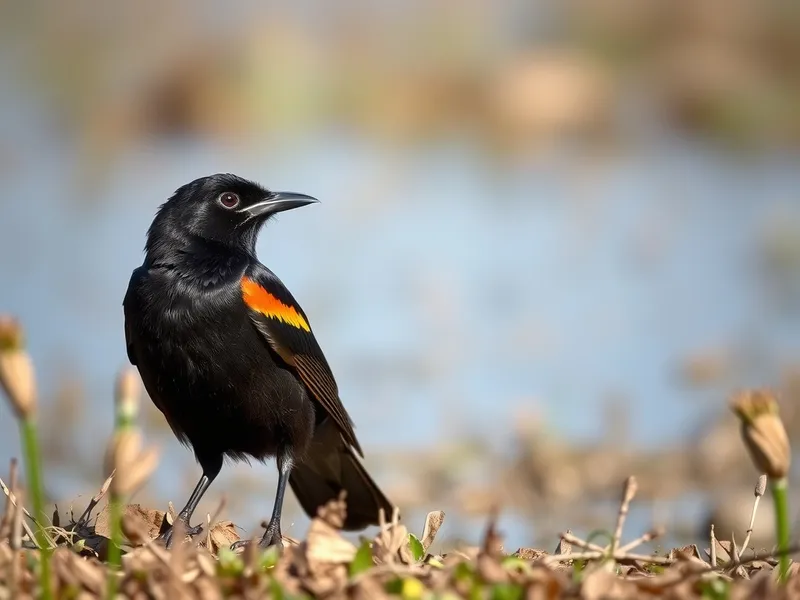
Red-winged Blackbird
Agelaius phoeniceus

Meet the Red-winged Blackbird
The Red-winged Blackbird is a medium-sized songbird notable for the male's striking black plumage accented by vivid red and yellow shoulder patches, or epaulets. Females are brown and heavily streaked, often mistaken for sparrows. Commonly found throughout North America, these birds are highly adaptable and thrive in wetlands, marshes, and agricultural areas. Their loud, distinctive 'conk-la-ree!' call is a familiar sound in spring and summer. Social and territorial, Red-winged Blackbirds are known for their aggressive defense of nesting sites.
Classification
Bird
Habitat
Wetlands, marshes, and open fields
Diet
Omnivore
Lifespan
2-15 years
Conservation
Least Concern
Weight
32-77 grams
📖Fascinating Facts
Colorful Epaulets
Only male Red-winged Blackbirds display the bright red and yellow shoulder patches, which they use to attract females and intimidate rivals.
Vocal Defenders
These birds are highly territorial and use loud, recognizable songs to defend their nesting area from intruders.
Flexible Diet
Red-winged Blackbirds eat a varied diet of seeds, insects, and even small fruits, switching between food sources depending on the season.
📋Detailed Description
The Red-winged Blackbird (Agelaius phoeniceus) is a medium-sized passerine, measuring 17–23 cm (6.7–9.1 in) in length with a wingspan of 31–40 cm (12–16 in), and weighing 32–77 g (1.1–2.7 oz). Males are unmistakable, with glossy black plumage and prominent red epaulets bordered by yellow, which they display during territorial and courtship behaviors. Females are smaller, heavily streaked brown and tan, and possess a more slender bill, providing camouflage among marsh vegetation. The species exhibits pronounced sexual dimorphism, not only in plumage but also in size and vocalizations. Red-winged Blackbirds are highly gregarious outside the breeding season, forming massive flocks that may include other blackbird species. Their vocal repertoire is complex, with the iconic 'conk-la-ree!' song used for territory defense and mate attraction. They are primarily found in wetlands, but their adaptability allows them to exploit agricultural fields, grasslands, and even urban environments. Their diet is omnivorous, shifting seasonally between seeds, grains, and a wide array of invertebrates. The Red-winged Blackbird is polygynous, with dominant males defending territories that may contain the nests of multiple females. Their aggressive nest defense is notable, as they will attack much larger animals, including humans, to protect their young.
💡 Did you know?
A single male Red-winged Blackbird can have up to 15 female mates within his territory during a single breeding season.
🔬Research & Sources
Wikipedia Summary
The red-winged blackbird is a passerine bird of the family Icteridae found in most of North America and much of Central America. It breeds from Alaska and Newfoundland south to Florida, the Gulf of Mexico, Mexico, and Guatemala, with isolated populations in western El Salvador, northwestern Honduras, and northwestern Costa Rica. It may winter as far north as Pennsylvania and British Columbia, but northern populations are generally migratory, moving south to Mexico and the Southern United States. Claims have been made that it is the most abundant living land bird in North America, as bird-counting censuses of wintering red-winged blackbirds sometimes show that loose flocks can number in excess of a million birds per flock and the full number of breeding pairs across North and Central America may exceed 250 million in peak years. It also ranks among the best-studied wild bird species in the world. The red-winged blackbird is sexually dimorphic; the male is all black with a red shoulder and yellow wing bar, while the female is a nondescript dark brown. Seeds and insects make up the bulk of the red-winged blackbird's diet.
Last Modified: 6/2/2025
🎭Behavior & Social Structure
Red-winged Blackbirds exhibit pronounced territoriality during the breeding season, with males vigorously defending territories through song, display, and physical aggression. Males perch conspicuously to advertise their presence, fluffing their epaulets and spreading their wings. Outside of breeding, they are highly social, forming flocks that can number in the hundreds of thousands, especially during migration and winter. Foraging occurs both on the ground and in vegetation, with birds probing for seeds, grains, and insects. They often feed in mixed-species flocks with other icterids. Daily routines include early morning and late afternoon feeding, with midday periods spent preening or resting. Roosting at night occurs communally, often in dense reed beds or trees. Alarm calls and mobbing behavior are common responses to predators, and cooperative vigilance enhances group safety.
👶Reproduction & Life Cycle
Breeding occurs from March to August, varying with latitude. Males establish and defend territories of 0.2–0.4 hectares (0.5–1 acre), attracting up to 15 females, though most territories host 2–5. Females build cup-shaped nests low in dense vegetation, typically over water. Clutch size ranges from 3–5 pale blue eggs, which are incubated solely by the female for 11–13 days. Nestlings are altricial and fledge at 11–14 days old. Females provide the majority of parental care, feeding the young a diet rich in insects. Males may assist in feeding but primarily focus on territory defense and attracting additional mates. Double brooding is common in southern populations, while northern birds usually raise a single brood per season.
🛡️Adaptations & Survival
Red-winged Blackbirds possess several adaptations for wetland life, including strong legs and feet for perching on reeds and cattails. Their conical bills are efficient for extracting seeds and capturing insects. The male's epaulets are a key adaptation for social signaling, with their size and color intensity correlating with dominance and reproductive success. Behavioral plasticity allows them to exploit a variety of habitats, including disturbed and agricultural areas. Their aggressive nest defense reduces predation risk, and their ability to form large communal roosts provides safety in numbers. Seasonal dietary shifts enable them to exploit abundant food resources throughout the year.
🎨Cultural Significance
Red-winged Blackbirds are prominent in North American folklore and literature, often symbolizing the arrival of spring and the vibrancy of wetlands. Their striking appearance and loud calls make them a familiar presence in rural and suburban landscapes. In some Native American traditions, blackbirds are seen as messengers or symbols of change. Conversely, their large flocks and crop-raiding behavior have led to negative perceptions among farmers, resulting in their portrayal as agricultural pests. They have been featured in poetry, music, and visual art, reflecting both their beauty and ubiquity.
🔬Recent Research & Discoveries
The Red-winged Blackbird is one of the most intensively studied wild bird species, serving as a model for research in behavioral ecology, sexual selection, and population dynamics. Recent studies have explored the genetic basis of plumage coloration, the role of epaulet size in male competition, and the effects of environmental contaminants on reproductive success. Long-term banding and monitoring projects have provided valuable insights into migration patterns, longevity (with individuals recorded living up to 15 years in the wild), and the impacts of climate change on phenology. Ongoing research continues to examine their responses to habitat alteration and the ecological consequences of their large population size.
🎥Wildlife Videos

One of the Most Numerous Land Birds | Red-winged Blackbird
Learn more interesting facts about the Red-winged Blackbird in this video. Red-winged blackbirds breed in wetlands across ...
Lesley the Bird Nerd

EVERYTHING you DIDN'T know about the Red-winged Blackbird
In this video I go into depth on what makes the Red-winged Blackbird so special. Check out my new bird/birding education ...
Bright-Eyed Birding

Red-winged Blackbird - HD Mini-documentary
Transcript: "The Red-Winged Blackbird is found throughout most of North and Central America. Northern populations of the ...
James Knott

Funny and Cute, amazing Babies - Red-winged blackbirds #. 4K Video. Wildlife Photography
Funny and Cute #Red-winged blackbirds #amazing #Babies. #Wildlife Photography Screech Owls ...
Wildlife Documentaries, Beso Nikuradze

Nature Shorts: Red-winged Blackbird
A short nature documentary featuring clips of Red-winged blackbirds in MA in spring, and produced, filmed, edited, and voiced by ...
Worrest Photography

Red winged Blackbird Display
How Nature Works male displays, calls, and feather preening, look at the territorial displays and breeding behavior of Red-winged ...
sophiee croww
🌍Habitat Information
The Red-winged Blackbird typically inhabits Wetlands, marshes, and open fields environments. Red-winged Blackbirds have adapted to their environments with specialized features and behaviors.
Primary Habitat:
Wetlands, marshes, and open fields
More detailed habitat information will be available soon.
🛡️Conservation Status
The Red-winged Blackbird is currently classified as Least Concern. Conservation efforts are crucial for preserving this species for future generations.
Common Threats:
- 🏠Habitat loss and fragmentation
- 🌡️Climate change impacts
- 🎯Hunting and poaching
- 🏭Human-wildlife conflict
⚠️Threats & Conservation Challenges
Despite their abundance, Red-winged Blackbirds face threats from habitat loss, particularly the drainage of wetlands for agriculture and development. Pesticide use can reduce insect prey and cause direct mortality. Large-scale control efforts, especially in agricultural regions where they are considered crop pests, have historically resulted in significant mortality, though populations remain robust. Collisions with vehicles and structures, as well as predation by mammals, snakes, and birds of prey, are additional challenges. Climate change may alter the distribution and quality of wetland habitats, potentially impacting future populations. Nevertheless, their adaptability and high reproductive rate have allowed them to remain among the most numerous North American birds.
🔬Scientific Classification
Scientific Name
Agelaius phoeniceus
Classification Hierarchy
🔍 About Taxonomic Classification
Taxonomic classification is a hierarchical system used by scientists to classify and organize living organisms based on shared characteristics and evolutionary relationships.
The system moves from broad categories (Kingdom) to increasingly specific ones, with each animal's scientific name typically consisting of its Genus and species.
📝Community Notes
Share your observations and insights about the Red-winged Blackbird with our community of wildlife enthusiasts.
Join Our Community
Sign in to share your observations and connect with fellow wildlife enthusiasts.
Sign In to ContributeNo community notes yet
Be the first to share your observations about the Red-winged Blackbird!
Explore Red-winged Blackbird
Select a tab above to learn more about this amazing animal.
📸Photo Gallery
No photos available for this animal yet.
🌟Discover More Wildlife
Continue your journey of discovery with more fascinating animals from our database
